

3. Odds in Texas Hold’em
Texas Hold’em is a magnificent game of strategy and chance. Like the personalities, aspirations and abilities of the players, each hand is different.
Sometimes the only path to victory is to hold the best hand. And sometimes a player is able to execute strategies that will allow him to win even if both of his hole cards are blank.
Over time a player will receive the same cards and opportunities as any other player. Each player at the table has access to the same information as all other players at the table. The degree to which a player will triumph over the table depends on his ability to
1.Process and weigh available information as inputs into his decision support system
2.Devise and implement strategies based on that information.
Hold’em is the one poker variation that rewards skill and understanding above all others.
Basic poker odds and probability processing will tell the astute player some measure of
♦ The relative strength of his hand
45

3.Odds in Texas Hold’em
♦The likelihood that his hand will improve
♦Some idea of what his opponents are holding.
Simple observations will give the astute player a reasonable idea of the likely actions of opponents in certain situations. The poker artiste will use this information plus his advanced gamesmanship to execute strategies that will give him a much higher expectation.
The best poker decisions are those based on the best strategy and the best strategy is based on the best information.
Game theory teaches that strategic thought is mostly about the anticipation of the actions and reactions of your opponents.
Basic odds and probabilities tell a player much about his own hand and its likelihood of success. Those same odds apply individually and collectively to all other players at the table.
It is around the margins of strong hands where a game is optimized. The degree to which a player is able to successfully model an opponent’s likely strength and — from past observations — is able to predict the opponent’s likely response is equal to the degree to which he will be able to get optimal return from almost any hand he chooses to play.
The key to enhancing the return from any player’s game is learning to weigh all available information to profitably play an otherwise marginal hand.
Adapted for poker, various translations of the writings of Sun Tzu have loosely stated that, if in every situation of battle a player
46

3. Odds in Texas Hold’em
♦knows more about his own strengths, weaknesses and intentions than is known by his opponents;
♦knows as much about his opponents’ strengths, weaknesses and intentions as is known by his opponents themselves; and
♦has the Tao, in the case of poker — the odds/expectation, on his side;
then, that player will triumph in battle after battle.
While a study of the Odds can do much to help you predict the Cards to come, it is from a study of your Opponents that you can surmise much about the Action to come.
All players get the same number of good hands. It is the rare and, oftentimes, extremely successful player who can win pots with very strong hands and very weak hands alike.
The most valuable ability in all of poker is the ability to win without having the best hand.
This chapter is organized to present tables with odds for each round of betting, and demonstrate below each table the calculations of those odds.
Basic calculations will explain how often the player will see certain starting hands, how often those starting hands will complete into winning hands and whether certain hands are worth drawing to from a money/expectation perspective.
Those same basic calculations speak volumes about the likely strength of the opponents. When combined with the knowledge of how a given opponent has behaved in the past,
47

3. Odds in Texas Hold’em
the artiste can anticipate his opponent’s strength and likely action or reaction.
A player’s Total Odds of winning the pot combine his odds that he has or will have the best hand with his odds of being able to manipulate his opponents out of the hand.
48

Starting Hands
Starting Hands
Your first chance to gain an edge over your opponents is with your starting hands. Some hands, like suited connectors, have longer odds of improving and thus do better when you have more money/players in the pot. Other hands, like big Pocket Pairs such as AA or KK, are already “made” hands and do better with fewer players drawing against them.
Just knowing what hands to play from what position and how to play them will give a player a big edge.
An even bigger edge comes from knowing your opponents and their likely actions and reactions.
This section will give you a good idea of what to expect from starting hands and how often to expect them.
Your Odds = Your Opponent’s Odds
Your odds of getting any of the hands shown below are exactly the same as for any one of your opponents.
While it is true that you will find rags in the hole four out of five times — it is also true that four out of five of your opponents will also find rags in the hole.
The tables, calculations and methods below demonstrate the characteristics of a normal distribution of starting hands.
From this, a player can always have an idea of what to expect and how often to expect it, plus a good idea of both the individual and collective expectations of his opponents.
49

3. Odds in Texas Hold’em
In a full 10-handed Hold’em game, some reasonable expectations about starting hands and some derived points of inference from those expectations are as follows:
♦Once in an average of approximately every 55 hands (5.5 rounds) seen by you or by any one of your opponents, you or that specific opponent will receive a pair of Jacks or better in the hole. The corollary follows.
♦Once in roughly every 5.5 hands (slightly less often than twice every round) someone — anyone at the table — will receive a pair of Jacks or better in the hole.
♦Playing online at 4 tables simultaneously with an average of 60 hands per hour per table, someone at one of the 4 tables will have a pair of Jacks or better in the hole roughly every 80 seconds.
♦Slightly more often than once every other round (1 in 17 hands) you or any specific one of your opponents will receive a Pocket Pair.
♦On average, for every 17 sets of hole cards dealt, which is slightly more than once every other hand, someone at the table will hold a Pocket Pair.
♦With over 80% of possible starting hands designated as rags, with not every non-rag hand playable in every situation, and with the exception of blinds and special situations, UPWARDS OF
90% OF ANY PLAYER’S STARTING HANDS SHOULD BE DEEMED UNPLAYABLE.
♦On average there will be almost 2 non-rag hands dealt per round. If 3 or more non-blind players pay
50
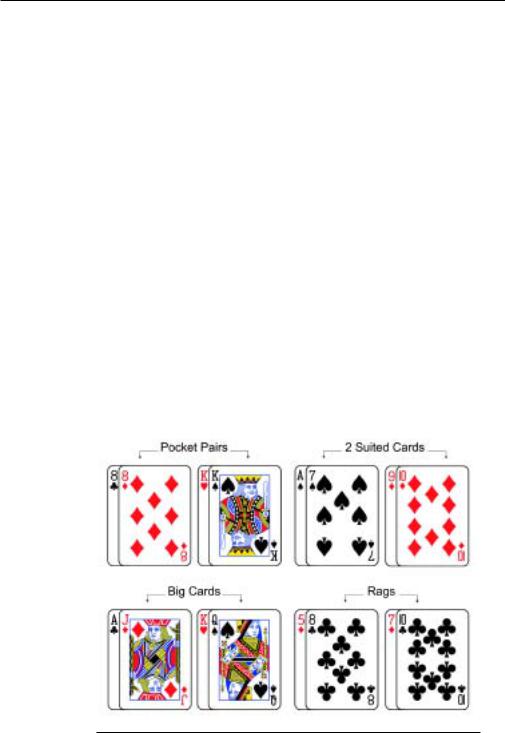
Starting Hands
to see the Flop on a consistent basis, you can tell how loose or tight that game is.
♦If any particular player pays to see the Flop more than once every three hands, assume that for at least some of those hands, he’s playing rags.
Odds & Probabilities
First you will be dealt one of 1,326 possible starting hands. This number results from the combinations formula demonstrated in Chapter 1 — The Basic Calculations —
Comb(52, 2):
(52 * 51) = 1,326 (1 * 2)
For purposes of classification, almost all of these 1,326 hands can be sorted into one of four categories:
51

3. Odds in Texas Hold’em
The table below displays both the odds and the probability that any given player will receive certain hands as his first two cards. The calculations to determine these odds and probabilities are demonstrated below the table.
Starting Hands — Odds/Probabilities
Hand |
Probability |
Odds |
|
|
|
Any Pair |
5.9% |
16 : 1 |
|
|
|
Any Specific Pair (AA) |
.452% |
220 : 1 |
|
|
|
Pair of Jacks or Better |
1.8% |
54.25 : 1 |
|
|
|
22 through TT |
4.10% |
23.6 : 1 |
|
|
|
Suited Connectors |
2.10% |
46.4 : 1 |
|
|
|
Suited Ace |
3.62% |
26.6 : 1 |
|
|
|
Any 2 Suited |
23.53% |
3.25 : 1 |
|
|
|
Any AK |
1.2% |
81.9 : 1 |
AKs |
.30% |
330.5 : 1 |
|
|
|
2 Unpaired Big Cards |
7.2% |
12.8 : 1 |
|
|
|
Any Ace |
14.50% |
5.9 : 1 |
Rags |
81% |
.23 : 1 |
|
|
|
*Note — Suited connectors calculated are 45 through TJ. 2 Big Cards refers to any 2 unpaired cards J or higher.
The Calculations
These odds and probabilities can be calculated at least two ways:
1.Combinations — Knowing the total number of possible 2-card combinations (1,326) and the number
52

Starting Hands
of combinations that will make the starting hand, the odds are easily calculated as demonstrated below.
2.Probabilities — The probability of any starting hand can easily be determined by multiplying the probability of the first card by the probability of the second.
As demonstrated in Chapter 1 — Basic Calculations — and throughout this book, any odds are easily converted into probabilities and vice versa.
Pocket Pairs
For each rank — cards 2 through A, there are 6 possible pair combinations — Comb(4, 2):
(4 * 3) = 6 (1 * 2)
With 13 ranks of 6 possible pair combinations there are 78 pair combinations possible from a standard 52-card deck.
The odds and probability that any given player will receive the Pairs listed below as his hole cards are:
Hand |
Probability |
Odds |
|
|
|
Any Pair |
5.9% |
16 : 1 |
|
|
|
Any Specific Pair (AA) |
.452% |
220 : 1 |
|
|
|
Pair of Jacks or Better |
1.8% |
54.25 : 1 |
|
|
|
22 through TT |
4.10% |
23.6 : 1 |
|
|
|
53
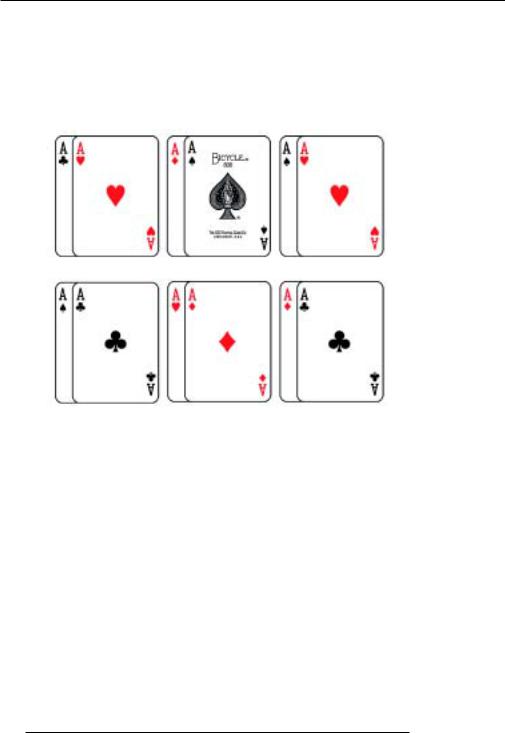
3. Odds in Texas Hold’em
Pocket Aces
There are 6 different 2-card combinations that WILL contain a pair of Aces — Comb(4, 2):
The number of 2-card combinations that WILL NOT contain a pair of Aces is Total Possibilities (1,326) — WILLs (6) = 1,320 WILLNOTs.
The odds against being dealt Aces in the hole in Hold’em are:
WILLNOTs (1,320) : WILLs (6) 1,320 : 6
Reduce 1,320 / 6 : 6 / 6
220 : 1
Another way is to determine the probability of being dealt Aces in the hole, by multiplying the probability of being dealt the first Ace by the probability of being dealt the second Ace:
54

Starting Hands
524 * 513 = .0045249
This probability, expressed as a percentage (.0045249 * 100), is less than one half of one percent or .45249%.
As a check, we can convert the probability expressed as a decimal ratio to 1 (.0045249) back to odds:
WILLs |
= Probability as decimal ratio to 1 |
Total Possibilities |
Odds = WILLNOTs : WILLs
Total Possibilities = 1
– WILLs = .0045249
WILLNOTs = .9954751
WILLNOTs : WILLs
.9954751 : .0045249 Reduce
.9954751 / .0045249 : .0045249 / .0045249
220 : 1
Any Pocket Pair
The likelihood of any Pair in the hole for any given player expressed as odds is:
Total Possibilities = 1,326
Total Possible Pairs (WILLs) = 78
Total Possibilities = 1,326
– WILLs = 78
WILLNOTs = 1,248
55

3. Odds in Texas Hold’em
WILLNOTs (1,248) : WILLs (78) 1,248 : 78
Reduce 1,248 / 78 : 78 / 78
16 : 1
The likelihood of any Pair in the hole expressed as a probability is
WILLs |
* 100 |
= Probability as % |
||
Total Possibilities |
||||
|
|
|||
78 |
* 100 |
= 5.9% |
||
|
1,326 |
|||
On average you will be dealt a Pocket Pair once in 17 hands or roughly 6% of the time.
Pocket JJ or Better
For JJ through AA there are 24 (6 * 4) possible pair combinations from 1,326 total possible 2-card combinations:
Possible Pairs JJ or Better (WILLs) = 24
Total Possibilities = 1,326
– WILLs = 24
WILLNOTs = 1,302
WILLNOTs (1,302) : WILLs (24) 1,302 : 24
Reduce 1,302 / 24 : 24 / 24
54.25 : 1
56

Starting Hands
The probability of a pair of Jacks or better in the hole is
WILLs |
* 100 |
= Probability as % |
||
Total Possibilities |
||||
|
|
|||
24 |
* 100 |
= 1.8% |
||
|
1,326 |
|||
On average you will be dealt Pocket Jacks or better once in 55.25 hands or roughly 2% of the time.
Pocket 22 through TT
For 22 through TT there are 54 (9 * 6) possible pair combinations from 1,326 total possible 2-card combinations.
Possible Pairs 22 through TT (WILLs) = 54
Total Possibilities = 1,326
– WILLs = 54
WILLNOTs = 1,272
WILLNOTs (1,272) : WILLs (54) 1,272 : 54
Reduce 1,272 / 54 : 54 / 54
23.6 : 1
The likelihood of pocket 22 through TT, expressed as a probability, is shown below — first as a percentage calculation then as a combination of probabilities.
Percentage calculation:
WILLs |
* 100 = Probability as % |
|
Total Possibilities |
||
|
57

3. Odds in Texas Hold’em
54 |
* 100 = 4.1% |
1,326 |
Combination of Probabilities:
There are 36 cards in the deck with a rank of 2 through T, but there are only 4 cards of each rank from which your Pair can be dealt. The probability of the first card is 36/52 and the probability of the second card is 3/51:
3526 * 513 = .0407
It is very easy to calculate odds and probabilities using these methods.
On average you will be dealt pocket 22 through TT once in 24.6 hands or roughly 4.1% of the time.
Suited Cards
Given enough action, suited cards — especially suited connectors — can make great drawing hands.
The table below reflects the likelihood that any given player will hold any two suited cards, suited connectors or a suited Ace (Ax).
Hand |
Probability |
Odds |
|
|
|
Suited Connectors |
2.10% |
46.4 : 1 |
|
|
|
Suited Ace |
3.62% |
26.6 : 1 |
|
|
|
Any 2 Suited |
23.53% |
3.25 : 1 |
|
|
|
*Note — Suited connectors calculated are 45 through TJ.
58

Starting Hands
Suited Connectors
These are the connectors that will make a Straight when combined with 3 cards in either or both directions.
There are 7 ranks and 4 suits so 7 * 4 = 28 possible suited connectors 45 through TJ from 1,326 total possible 2-card combinations:
Suited Connectors 45 through TJ (WILLs) = 28
Total Possibilities = 1,326
– WILLs = 28
WILLNOTs = 1,298
WILLNOTs (1,298) : WILLs (28) 1,298 : 28
Reduce 1,298 / 28 : 28 / 28
46.4 : 1
The probability of suited 45 through TJ in the hole is
WILLs |
* 100 = Probability as % |
|
Total Possibilities |
||
|
1,32628 * 100 = 2.1%
On average you will be dealt one of these sets of suited connectors once in 47.4 hands or roughly 2.1% of the time.
Any Suited Ace — Axs
There are 12 Ax combinations for each of the 4 suits, resulting in 48 possible Ax suited combinations:
59

3. Odds in Texas Hold’em
Axs Combinations (WILLs) = 48
Total Possibilities = 1,326
– WILLs = 48
WILLNOTs = 1,278
WILLNOTs (1,278) : WILLs (48) 1,278 : 48
Reduce 1,278 / 48 : 48 / 48
26.6 : 1
The probability of Axs in the hole is
WILLs |
* 100 |
= Probability as % |
||
Total Possibilities |
||||
|
|
|||
48 |
* 100 |
= 3.6% |
||
|
1,326 |
|||
On average you will be dealt Axs once in 27.6 hands or roughly 3.6% of the time.
Any 2 Suited
Because the first card can be any card in the deck, the probability that you will be dealt 2 suited cards is equal to the probability that the suit of the second card will match the suit of the first:
WILLs |
* 100 = Probability as % |
|
Total Possibilities |
||
|
1251 * 100 = 2.1%
To convert this probability to odds:
60

Starting Hands
Total Possibilities = 51
– WILLs = 12
WILLNOTs = 39
WILLNOTs (39) : WILLs (12) 39 : 12 Reduce
39 / 12 : 12 / 12
3.25 : 1
To verify this somewhat different approach, calculate the same odds using sets and combinations.
To find the odds against 2 suited cards in the hole, first find the number of possible 2-card combinations for each suit — Comb(13, 2), then multiply by 4:
(13 * 12) * 4 = 312 (1 * 2)
WILLs = 312
Total Possibilities = 1,326
– WILLs = 312
WILLNOTs = 1,014
WILLNOTs (1,014) : WILLs (312) 1,014 : 312
Reduce
1,014 / 312 : 312 / 312
3.25 : 1
Your hole cards will be suited once every 4.25 hands or on average 23.5% of the time.
61

3. Odds in Texas Hold’em
2 Big Cards
This table shows the odds that any given player’s hole cards will be certain Big Card combinations.
Hand |
Probability |
Odds |
|
|
|
Big Slick — Any AK |
1.2% |
81.9 : 1 |
Suited Big Slick — AKs |
.3% |
330.5 : 1 |
|
|
|
2 Unpaired Big Cards |
7.2% |
12.8 : 1 |
|
|
|
Any Ace |
14.5% |
5.9 : 1 |
Big Slick — Any AK
There are 4 * 4 = 16 2-card combinations that WILL make any AK including AKs.
Total Possibilities = 1,326
– WILLs = 16
WILLNOTs = 1,310
WILLNOTs (1,310) : WILLs (16) 1,310 : 16
Reduce 1,310 / 16 : 16 / 16
81.9 : 1
The probability of Big Slick in the hole is:
WILLs |
* 100 |
= Probability as % |
||
Total Possibilities |
||||
|
|
|||
16 |
* 100 |
= 1.2% |
||
|
1,326 |
|||
62

Starting Hands
On average you will be dealt Big Slick once in 82.9 hands or roughly 1.2% of the time. This includes the possibility that the hand will be suited.
Suited Big Slick — AKs
There are only 4 2-card combinations that WILL make AK suited:
Total Possibilities = 1,326
– WILLs = 4
WILLNOTs = 1,322
WILLNOTs (1,322) : WILLs (4) 1,322 : 4
Reduce 1,322 / 4 : 4 / 4
330.5 : 1
The probability of suited Big Slick in the hole is
WILLs |
* 100 |
= Probability as % |
||
Total Possibilities |
||||
|
|
|||
4 |
* 100 |
= .3% |
||
|
1,326 |
|||
On average you will be dealt Big Slick suited once in 331.5 hands or roughly .3% of the time.
2 Unpaired Big Cards
These are the number of possible 2-card combinations that contain 2 unpaired cards of Jack or better.
63

3. Odds in Texas Hold’em
Among the 16 cards in the deck with a rank of Jack or better there are 120 possible combinations calculated as Comb(16, 2):
(16 * 15) = 120 (1 * 2)
This number includes 24 possible pair combinations. There are 120 – 24 = 96 combinations that WILL contain 2 unpaired cards above the rank of Ten.
Another way is to multiply the probability of the first card by the probability of the second. In this case, after the first card is dealt, there are only 12 cards left that will not pair the first card:
(16 * 12) / (1 * 2) = 96 (WILLs)
Total Possibilities = 1,326
– WILLs = 96
WILLNOTs = 1,230
WILLNOTs (1,230) : WILLs (96) 1,230 : 96
Reduce 1,230 / 96 : 96 / 96
12.8 : 1
The probability of 2 unpaired Big Cards in the hole is
WILLs |
* 100 |
= Probability as % |
||
Total Possibilities |
||||
|
|
|||
96 |
* 100 |
= 7.2% |
||
|
1,326 |
|||
On average you will be dealt 2 unpaired Big Cards once in 13.8 hands or roughly 7.2% of the time.
64

Starting Hands
Any Ace
There are 4 * 48 = 192 2-card combinations that WILL make a hand that includes Ax:
Total Possibilities = 1,326
– WILLs = 192
WILLNOTs = 1,134
WILLNOTs (1,134) : WILLs (192) 1,134 : 192
Reduce 1,134 / 192 : 192 / 192
5.9 : 1
The probability of any Ace in the hole is
WILLs |
* 100 |
= Probability as % |
||
Total Possibilities |
||||
|
|
|||
192 |
* 100 |
= 14.5% |
||
|
1,326 |
|||
On average you will be dealt an Ace once in every 6.9 hands or roughly 15% of the time.
Rags
Rags are all the hands not mentioned above. Rags are the hands that are left over after all the good hands have been taken out. Rags are usually not playable except in special situations or for free from the blind.
With a given caveat that some small number of hands might be duplicated, i.e., suited connectors and 2 Big Cards, we will
65

3. Odds in Texas Hold’em
consider the number of rag hands to be the total number of possible hands (1,326) minus all of the non-rag hands.
Non-Rag Hands
The WILLNOTs are all of the non-rag hands:
78 |
– Pair Hands |
|
28 |
– Suited Connectors |
|
48 |
– Suited Ace |
|
96 |
– 2 Unpaired Big Cards |
|
250 |
– Non-Rag Hands (WILLNOTs) |
|
To find the likelihood of rags in the hole, subtract the total number of non-rag hands (WILLNOTs) from the Total Possible hands to find the number of possible rag hands (WILLs):
Total Possibilities = 1,326
– WILLs = 250
WILLNOTs = 1,076
WILLNOTs ( 1,076) : WILLs ( 250) 1,076 : 250
Reduce
1,076 / 250 : 250 / 250
.23 : 1
The probability of rags in the hole is
WILLs |
* 100 = Probability as % |
|
Total Possibilities |
||
|
66

Starting Hands
1,0761,326 * 100 = 81.2%
On average you will be dealt rags 4 out of 5 hands or slightly over 81% of the time.
67

3. Odds in Texas Hold’em
Before the Flop
After the hole cards have been dealt and before the Flop some primary concerns are
1.Relative strength of the hand
2.Likelihood the hand will improve
3.Likely strength of competition
4.Estimated cost to continue in the hand
5.Estimated size of the final pot
6.Possible moves to eliminate competitors.
The section on starting hands gives a good idea of the relative rarity/strength of certain holdings and the likelihood that opponents will hold those same hands.
For example, from the discussion on starting hands we can see that the probability of being dealt a Pocket Pair is 1/17. The work below reveals that the probability of flopping a Set or better with a Pair in the hole is 1/8.51. By multiplying these probabilities it becomes known that only once in approximately every 145 hands you or any other specific player will flop a hidden Set.
With an average of 20–40 hands dealt per hour in casino poker and 50–70 hands dealt per hour in online poker, on average you will flop a Set or better to a Pocket Pair only once every 4–5 hours in the casino and once every 2–3 hours online.
Important to note from a game theory perspective: On average, someone at each table (but not necessarily you)
68

Before the Flop
will flop this same hidden Set once every 12–18 minutes online and once every 25–40 minutes in the casino.
Most pre-Flop odds calculations relate to the likelihood that certain hands will improve. To help organize these calculations, almost all possible starting hands can be placed into one of four classifications:
1.Pocket Pairs
2.2 Suited Cards
3.Big Cards
4.Rags.
Most of the work in this section refers to the odds of improvement of certain hands. Players generally find “odds of improvement” easier to work with than “probability of improvement” because, for them, it is easier to relate those odds to the money odds in order to determine expectation.
Any expression of odds can easily be converted to an expression of probability. For example, with a Pair in the pocket, the odds against flopping a Set and a Set only are 8.28 : 1.
To convert these odds to an expression of probability:
WILLNOTs : WILLs
8.28 : 1
WILLs = 1
+ WILLNOTs = 8.28
Total Possibilities = 9.28
WILLs |
* 100 = Probability as % |
|
Total Possibilities |
||
|
69

3. Odds in Texas Hold’em
9.281 * 100 = 10.8%
The odds of 8.28 : 1 and the probability of 10.8% are two different ways of saying the same thing.
This table reflects the odds of improvement on the Flop for some of the most common starting hands, followed by tables and text that demonstrate their calculation.
Starting Hand |
Hand to Flop |
Odds |
|
|
|
Pocket Pair |
Set Only |
8.28 : 1 |
|
|
|
Pocket Pair |
Set or Boat |
7.5 : 1 |
Pocket Pair |
Boat |
101.1 : 1 |
|
|
|
Pocket Pair |
Quads |
407.3 : 1 |
|
|
|
Pocket Pair |
Set or Better |
7.3 : 1 |
|
|
|
Pocket Pair |
2 Pair |
5.19 : 1 |
|
|
|
Suited Connectors |
Flush Draw |
8.14 : 1 |
|
|
|
Suited Connectors |
Flush |
117.8 : 1 |
|
|
|
Suited Connectors |
Straight Draw |
9.2 : 1 |
|
|
|
Suited Connectors |
Straight |
75.56 : 1 |
Suited Connectors |
Straight Flush Draw |
141 : 1 |
|
|
|
Suited Connectors |
Straight Flush |
4,899 : 1 |
|
|
|
2 Suited |
Pair Either |
2.45 : 1 |
2 Suited |
Pair Both |
48.49 : 1 |
|
|
|
2 to Royal Flush |
Royal Flush Draw |
138 : 1 |
|
|
|
2 to Royal Flush |
Royal Flush |
19,599 : 1 |
|
|
|
Ax Suited |
Pair of Aces |
5 : 1 |
|
|
|
Ax Suited |
Ace Flush Draw |
8.14 : 1 |
70

|
|
|
Before the Flop |
|
|
|
|
|
|
|
Starting Hand |
Hand to Flop |
Odds |
|
|
|
|
|
|
|
Ax Suited |
Ace High Flush |
117.8 : 1 |
|
|
|
|
|
|
|
2 Unpaired Cards |
Pair a Certain |
5 : 1 |
|
|
|
Hole Card |
|
|
|
2 Unpaired Cards |
Pair Either |
2.45 : 1 |
|
|
|
Hole Card |
|
|
|
2 Unpaired Cards |
Pair Both Hole |
48.49 : 1 |
|
|
|
Cards |
|
|
|
2 Unpaired Cards |
A Set of Either |
73.24 : 1 |
|
|
|
Hole Cards |
|
|
|
|
|
|
|
The Calculations
One number that will be used throughout these calculations is the total number of possible 3-card Flops. Using the basic formula for combinations and given your 2 hole cards, determine the total number of possible 3-card Flops from the remaining 50 cards — Comb(50, 3):
(50 * 49 * 48) = 19,600 (1 * 2 * 3)
Pocket Pairs
With a Pair in the pocket it is not possible to flop a Straight or a Flush. The possible improvements to a Pocket Pair on the Flop are two Pair, a Set, a Full House (Boat) or Quads.
Starting Hand |
Hand to Flop |
Odds |
|
|
|
Pocket Pair |
Set Only |
8.28 : 1 |
|
|
|
Pocket Pair |
Set or Boat |
7.5 : 1 |
|
|
|
71

3. Odds in Texas Hold’em
Starting Hand |
Hand to Flop |
Odds |
|
|
|
Pocket Pair |
Boat |
101.1 : 1 |
|
|
|
Pocket Pair |
Quads |
407.3 : 1 |
|
|
|
Pocket Pair |
Set or Better |
7.3 : 1 |
Pocket Pair |
2 Pair |
5.19 : 1 |
|
|
|
Pocket Pair >>> Set Only
To find the odds of flopping a Set and a Set only we need to find the number of possible Flops that will include one of the cards to make the Set and no Pair.
First find the number of 2-card combinations possible from the remaining unseen 50 cards minus the 2 cards that will make the Set — Comb(48, 2):
(48 * 47) = 1,128 (1 * 2)
There are 1,128 2-card combinations that do not include the 2 cards either one of which will make the Set. From this number subtract all of the possible 2-card combinations in the deck that are Pairs (78) minus the 6 Pairs that come from the rank of the hole cards (72):
1,128 – 72 = 1,056
Multiply this number (1,056) by the number of remaining cards that WILL make the Set (2) and you will have the number of possible 3-card Flops that will make the Set and the Set only:
1,056 * 2 = 2,112
72

Before the Flop
We now have all the numbers needed to calculate the odds of flopping a Set and Set only:
Total Possibilities = 19,600
– WILLs = 2,112
WILLNOTs = 17,488
Odds of Flopping a Set Only with a Pocket Pair WILLNOTs : WILLs
17,488 : 2,112 Reduce
17,488 / 2,112 : 2,112 / 2,112
8.28 : 1
Pocket Pair >>> Set or Full House
This calculation is much the same as the one above except you don’t subtract the possible Pairs from the possible 2- card combinations.
First find the number of 2-card combinations possible from the remaining unseen 50 cards minus the 2 cards that will make the Set — Comb(48, 2):
(48 * 47) = 1,128 (1 * 2)
Multiply the result (1,128) by the number of remaining cards that WILL make the Set (2) and you will have the number of possible 3-card Flops that will make the Set or a Full House:
1,128 * 2 = 2,256
Also there is the possibility that a Set could come on the Flop, which would also make a Full House with the Pair in
73

3. Odds in Texas Hold’em
the pocket. From the 12 ranks that do not include the rank of the Pocket Pair there are 48 different 3-card combinations that are Sets — Comb(4, 3):
(4 * 3 * 2) * 12 = 48 (1 * 2 * 3)
In all there are 2,256 + 48 = 2,304 possible 3-card Flops that will make a Set or Full House when holding a Pocket Pair.
We now have all the numbers needed to calculate the odds of flopping a Set or a Full House:
Total Possibilities = 19,600
– WILLs = 2,304
WILLNOTs = 17,296
Odds of Flopping a Set or Boat with a Pocket Pair WILLNOTs : WILLs
17,296 : 2,304 Reduce
17,296 / 2,304 : 2,304 / 2,304
7.5 : 1
Pocket Pair >>> Full House
To flop a Full House with a Pair in the hole, the 3-card board must contain 1 of the remaining 2 cards that make the Set and any of the remaining 72 Pairs; or the Flop itself must be a Set. Any of the 72 Pairs may combine with either of the 2 cards that will make the Set to make the Full House, which means that there are:
72 * 2 = 144
74

Before the Flop
plus the 48 possible Sets that can come on the Flop to make 144 + 48 = 192 possible 3-card Flops that will make a Full House when holding a Pocket Pair.
We now have all the numbers needed to calculate the odds of flopping a Full House with a Pair in the hole:
Total Possibilities = 19,600
– WILLs = 192
WILLNOTs = 19,408
Odds of Flopping a Boat with a Pocket Pair WILLNOTs : WILLs
19,408 : 192 Reduce
19,408 / 192 : 192 / 192
101.1 : 1
Pocket Pair >>> Quads
To flop Quads with a Pair in the hole, 2 of the three Flop cards must be of the same rank as the Pocket Pair and the third card can be any of the remaining 48 unseen cards. With only 1 2-card combination for the first two cards and 48 possibilities for the third card, the number of possible 3- card Flops that WILL make Quads is
1 * 48 = 48
We now have all the numbers needed to calculate the odds of flopping 4 of a kind with a Pair in the hole:
Total Possibilities = 19,600
– WILLs = 48
WILLNOTs = 19,552
75

3. Odds in Texas Hold’em
Odds of Flopping Quads with a Pocket Pair WILLNOTs : WILLs
19,552 : 48 Reduce
19,552 / 48 : 48 / 48
407.3 : 1
Pocket Pair >>> Set or Better
Given all of the above calculations, finding the odds of flopping a Set, a Full House or Quads when holding a Pocket Pair is simply a matter of combining the WILLs.
Number of Flops that make a Set |
2,112 |
|
Number of Flops that make a Boat |
192 |
|
Number of Flops that make Quads |
48 |
|
|
|
|
Flops that WILL make a Set or better |
2,352 |
|
We now have all the numbers needed to calculate the odds of flopping a Set or better with a Pair in the hole:
Total Possibilities = 19,600
– WILLs = 2,352
WILLNOTs = 17,248
Odds of Flopping Set or Boat w/Pocket Pair WILLNOTs : WILLs
17,248 : 2,352 Reduce
17,248 / 2,352 : 2,352 / 2,352
7.3 : 1
76

Before the Flop
Pocket Pair >>> 2 Pair
To flop 2 Pair with a Pair in the hole, the Flop must contain a Pair and a third card that doesn’t match the Pocket Pair or the other cards on the board.
Without the rank of the Pocket Pair, there are 72 Pairs among the remaining 50 unseen cards.
To find the number of Flops that will make 2 Pair with a Pair in the pocket, multiply the number of possible Pairs (72) by the number of remaining unseen cards that will not match either the Pair in the hole or the Pair on the board, and that will not be the pair on the board (50 – 2 – 2 – 2 = 44):
72 * 44 = 3,168
We now have all the numbers needed to calculate the odds of flopping 2 Pair with a Pair in the hole:
Total Possibilities = 19,600
– WILLs = 3,168
WILLNOTs = 16,432
Odds of Flopping 2 Pair w/Pocket Pair WILLNOTs : WILLs
16,432 : 3,168 Reduce
16,432 / 3,168 : 3,168 / 3,168
5.19 : 1
Suited Cards
While any 2 suited cards can make a Flush, the most valuable suited cards are the suited connectors, and the higher the
77

3. Odds in Texas Hold’em
rank, the better. For our purposes, we will consider the suited connectors that range from 45 through TJ. These are the connectors that can make a Straight in both directions.
Ace–rag suited is a hand played far too often by beginning players. As we will demonstrate, this hand usually will not flop a Flush draw and when it does, most of the time it will not make the Flush. When the player does flop an Ace, he is left trapped with a top Pair and a weak kicker — a hand that can be a very expensive second-best.
The calculation of the odds that you will pair either or both of your two suited cards are contained in the section below on “2 Big Cards.”
2 Suited in the Hole
Starting Hand |
Hand to Flop |
Odds |
|
|
|
Suited Connectors |
Flush Draw |
8.14 : 1 |
Suited Connectors |
Flush |
117.8 : 1 |
|
|
|
Suited Connectors |
Straight Draw |
9.2 : 1 |
|
|
|
Suited Connectors |
Straight |
75.56 : 1 |
Suited Connectors |
Straight Flush Draw |
141 : 1 |
|
|
|
Suited Connectors |
Straight Flush |
4,899 : 1 |
|
|
|
2 Suited |
Pair Either |
2.45 : 1 |
|
|
|
2 Suited |
Pair Both |
48.49 : 1 |
|
|
|
2 to Royal Flush |
Royal Flush Draw |
138 : 1 |
2 to Royal Flush |
Royal Flush |
19,599 : 1 |
|
|
|
Ax Suited |
Pair of Aces |
5 : 1 |
|
|
|
Ax Suited |
Ace Flush Draw |
8.14 : 1 |
Ax Suited |
Ace High Flush |
117.8 : 1 |
78

Before the Flop
Suited Connectors
Suited connectors are hands that can offer great opportunity. A Rags Flop with small to medium suited connectors can sometimes leave the player in a dream situation: a big hand or big draw that is completely disguised.
The primary caveat for playing these hands, especially the connectors of medium to low rank, is that the player must have either
♦a firm indication that there will be a large enough final pot to make the draw worthwhile, or
♦a strong indication that some or all of the remaining players might fold to a properly executed bluff or semi-bluff.
2 Suited >>> Flush Draw
With 2 suited cards in the hole, calculate the odds of flopping a Flush draw by first finding the number of suited 2- card combinations possible from the remaining 11 suited cards — Comb(11, 2), and multiplying it by the number of unseen cards not of that suit (52 – 13 = 39), resulting in the number of Flops that WILL make a Flush draw.
Next, subtract the WILLs from the total number of possible Flops (19,600) to find the WILLNOTs. Reduce the result and you have the odds of flopping a Flush draw with 2 suited cards in the hole:
(11 * 10) = 55 (1 * 2)
79

3. Odds in Texas Hold’em
39 * 55 = 2,145
We now have all the numbers needed to calculate the odds of flopping a Flush draw with 2 suited cards in the hole:
Total Possibilities = 19,600
– WILLs = 2,145
WILLNOTs = 17,455
Odds of Flopping Flush Draw with 2 Suited WILLNOTs : WILLs
17,455 : 2,145 Reduce
17,455 / 2,145 : 2,145 / 2,145
8.14 : 1
2 Suited >>> Flush
To calculate the odds against flopping a Flush with 2 suited cards in the hole, first find the number of possible 3-card Flops where all three cards match the suit of the hole cards
— Comb(11, 3):
(11 * 10 * 9) = 165 (1 * 2 * 3)
We now have all the numbers needed to calculate the odds of flopping a Flush with 2 suited cards in the hole:
Total Possibilities = 19,600
– WILLs = 165
WILLNOTs = 19,435
Odds of Flopping Flush with 2 Suited WILLNOTs : WILLs
19,435 : 165
80
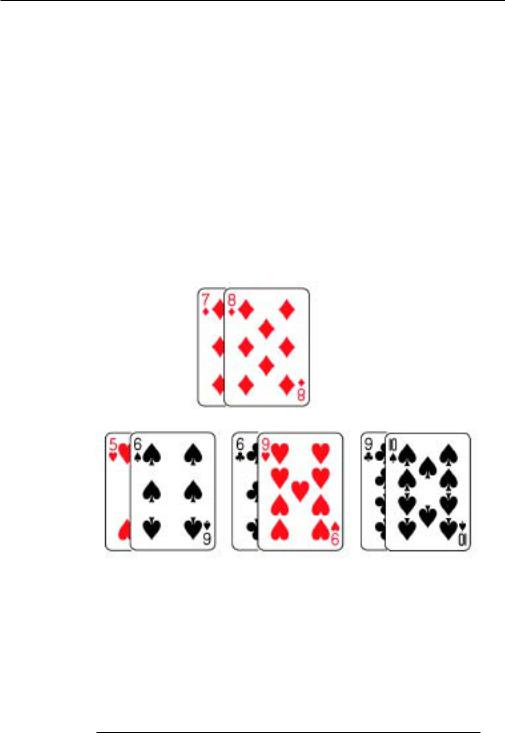
Before the Flop
Reduce 19,435 / 165 : 165 / 165
117.8 : 1
Suited Connectors >>> Open Ended
Straight Draw
For this calculation we will consider suited connectors from 45 through TJ.
With 7♦8♦ in the hole there are 3 2-card combinations that can appear on the Flop to make a Straight draw:
From each of these 2-card combinations there are 16 possible combinations. Therefore, there are 48 possible 2-card combinations that can be part of the Flop that will make an open ended Straight draw. This also includes the possibility that the Flop will pair either a hole card or a board card and that the open ended Straight draw might be a Straight Flush draw.
81

3. Odds in Texas Hold’em
After you subtract the 2 hole cards, the 2 cards that make the draw, and the 8 cards that would complete the Straight, there are 40 unseen cards left.
With the possibility that the Flop will pair either a hole card or a board card, the number of possible 3-card Flops that WILL make an open ended Straight draw to one of the suited connectors is
40 * 48 = 1,920
We now have all the numbers needed to calculate the odds of flopping an open ended Straight draw with 2 connected cards in the hole:
Total Possibilities = 19,600
– WILLs = 1,920
WILLNOTs = 17,680
Odds of Flopping Open Ended Straight Draw WILLNOTs : WILLs
17,680 : 1,920 Reduce
17,680 / 1,920 : 1,920 / 1,920
9.2 : 1
Suited Connectors >>> Straight
With one of the above-mentioned suited connectors in the hole, to calculate the odds of flopping a Straight, including a Straight Flush, first find the number of possible 3-card combinations that will flop a Straight. With 7♦8♦ in the hole, there are 4 possible 3-card combinations that will make a Straight:
82

Before the Flop
For each of these there are 4 * 4 * 4 = 64 possible combinations. Thus the number of possible 3-card Flops that will make the Straight is:
4 * 64 = 256
We now have all the numbers needed to calculate the odds of flopping a Straight with 2 connected cards in the hole:
Total Possibilities = 19,600
– WILLs = 256
WILLNOTs = 19,344
Odds of Flopping a Straight WILLNOTs : WILLs
19,344 : 256 Reduce
19,344 / 256 : 256 / 256
75.56 : 1
83
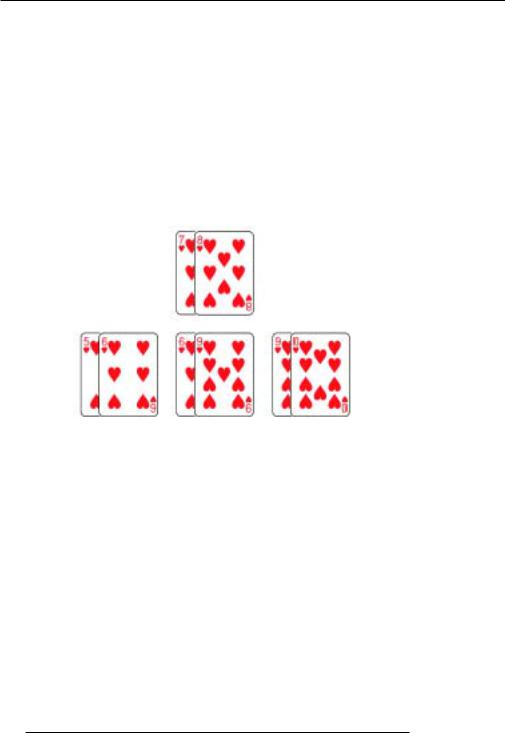
3. Odds in Texas Hold’em
Suited Connectors >>> Open Ended Straight Flush Draw
With one of the above-mentioned suited connectors in the hole, there are only 3 2-card combinations that will flop an open ended Straight Flush draw.
With 7♥8♥ in the hole there are 3 2-card combinations that can appear on the Flop to make a Straight Flush draw:
Minus the 2 hole cards and the 2 cards that make the draw and minus the 2 cards that would complete the Straight Flush, there are 46 unseen cards.
With the possibility that the Flop will pair either a hole card or a board card, the number of possible 3-card Flops that WILL make an open ended Straight Flush draw to one of the above-mentioned suited connectors is:
3 * 46 = 138
We now have all the numbers needed to calculate the odds of flopping an open ended Straight Flush draw with 2 suited and connected cards in the hole:
84

Before the Flop
Total Possibilities = 19,600
– WILLs = 138
WILLNOTs = 19,462
Odds of Flopping Open Ended Straight Draw WILLNOTs : WILLs
19,462 : 138 Reduce
19,462 / 138 : 138 / 138
141 : 1
Suited Connectors >>> Straight Flush
To find the odds of flopping a Straight Flush with one of the above-mentioned suited connectors in the hole, first find the number of possible 3-card combinations that will flop a Straight Flush.
With 7♥8♥ in the hole there are 4 possible 3-card combinations that will make a Straight Flush:
We now have all the numbers needed to calculate the odds of flopping a Straight Flush with 2 suited connected cards in the hole:
85
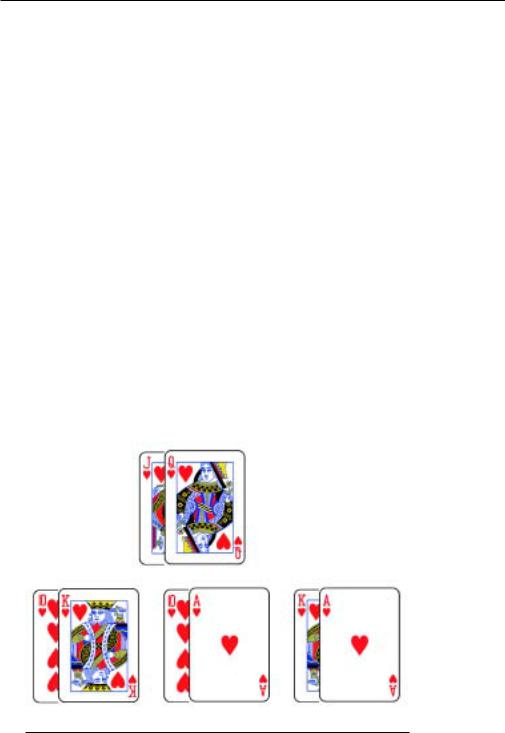
3. Odds in Texas Hold’em
Total Possibilities = 19,600
– WILLs = 4
WILLNOTs = 19,596
Odds of Flopping a Straight Flush WILLNOTs : WILLs
19,596 : 4 Reduce
19,596 / 4 : 4 / 4
4,899 : 1
2 Royal Cards >>> Royal Flush Draw
With 2 cards to a Royal in the hole there are only 3 2-card combinations that can appear on the Flop that will make a Royal Flush draw:
For example, with J♥Q♥ in the hole these are the only 3 2- card combinations that can come on the Flop to yield a Royal Flush draw:
86

Before the Flop
Minus the 2 hole cards and the 2 cards that make the draw, and minus the 1 card that would complete the Royal Flush, there are 47 unseen cards.
With the possibility that the Flop will pair either a hole card or a board card, the number of possible 3-card Flops that WILL make a Royal Flush draw is:
3 * 47 = 141
We now have all the numbers needed to calculate the odds of flopping a Royal Flush draw with 2 Royal cards in the hole:
Total Possibilities = 19,600
– WILLs = 141
WILLNOTs = 19,459
Odds of Flopping a Royal Flush Draw WILLNOTs : WILLs
19,459 : 141 Reduce
19,459 / 141 : 141 / 141
138 : 1
2 Royal Cards >>> Royal Flush
With 2 cards to a Royal Flush in the hole, there is only 1 3- card flop that WILL make the Royal.
We now have all the numbers needed to calculate the odds of flopping a Royal Flush with 2 Royal cards in the hole:
Total Possibilities = 19,600
– WILLs = 1
WILLNOTs = 19,599
87

3. Odds in Texas Hold’em
Odds of Flopping a Royal Flush WILLNOTs : WILLs
19,599 : 1 Reduce
19,599 / 1 : 1 / 1
19,599 : 1
2 Big Cards
Big Cards are any 2 cards Jack or higher. If the cards are paired then their odds of improvement are noted above. The same holds true if the 2 cards are either connected or suited.
Below are the calculations that the Flop will pair one particular card in the hole, will pair either card in the hole, will pair both cards in the hole, or will make a Set to either hole card.
Starting Hand |
Hand to Flop |
Odds |
|
|
|
2 Unpaired Cards |
Pair a Certain |
5 : 1 |
|
Hole Card |
|
2 Unpaired Cards |
Pair Either |
2.45 : 1 |
|
Hole Card |
|
2 Unpaired Cards |
Pair Both |
48.49 : 1 |
|
Hole Cards |
|
2 Unpaired Cards |
A Set of Either |
73.24 : 1 |
|
Hole Cards |
|
2 Unpaired Hole Cards >>> Pair a Specific Hole Card
To find the odds of flopping at least a pair of Aces with AJ in the hole, find the number of 2-card combinations that do not
88

Before the Flop
contain an Ace, and multiply that number by the number of remaining unseen Aces, resulting in the total number of possible 3-card combinations that will contain at least an Ace.
Subtract the 2 cards in the hole and the 3 remaining Aces, leaving 47 unseen cards none of which are Aces, then use
Comb(47, 2):
(47 * 46) = 1,081 (1 * 2)
With 1,081 possible 2-card combinations that contain no Aces and 3 remaining Aces unseen, the number of possible 3-card Flops that WILL flop at least a pair of Aces is
3 * 1,081 = 3,243
We now have all the numbers needed to calculate the odds of flopping at least a pair of Aces with AJ in the hole:
Total Possibilities = 19,600
– WILLs = 3,243
WILLNOTs = 16,357
Odds of Flopping at Least AA WILLNOTs : WILLs
16,357 : 3,243 Reduce
16,357 / 3,243 : 3,243 / 3,243
5 : 1
2 Unpaired Hole Cards >>> Pair Either Hole Card
To find the odds of flopping at least a Pair of either hole card
89

3. Odds in Texas Hold’em
with AJ in the hole, find the number of 2-card combinations that do not contain either an Ace or a Jack, multiply that number by the number of remaining unseen Aces and Jacks, giving you the total number of possible 3-card combinations that will contain at least one Ace or one Jack.
Subtract the 2 cards in the hole and the 6 remaining Aces and Jacks, leaving 44 unseen cards none of which are Aces or Jacks, then use Comb(44, 2):
(44 * 43) = 946 (1 * 2)
With 946 possible 2-card combinations that contain no Aces or Jacks plus 6 remaining Aces and Jacks, the number of possible 3-card Flops that WILL flop at least a pair of Aces or a pair of Jacks is
6 * 946 = 5,676
We now have all the numbers needed to calculate the odds of flopping at least a Pair of either Aces or Jacks with AJ in the hole:
Total Possibilities = 19,600
– WILLs = 5,676
WILLNOTs = 13,924
Odds of Flopping AA or JJ WILLNOTs : WILLs
13,924 : 5,676 Reduce
13,924 / 5,676 : 5,676 / 5,676
2.45 : 1
90

Before the Flop
2 Unpaired Hole Cards >>> Pair Both Hole Cards on the Flop
To find the odds of a Flop that will pair both hole cards with AJ in the hole, we know that 2 of the 3 Flop cards must be AJ. Find the number of possible AJ 2-card combinations from the remaining 3 Jacks and 3 Aces:
3 * 3 = 9
Minus the 2 cards in the hole and the 6 remaining Aces and Jacks there are 44 unseen cards, none of which are Aces or Jacks.
With 9 possible 2-card combinations that contain both an Ace and a Jack and 44 unseen cards that are neither an Ace or a Jack, the number of possible 3-card Flops that WILL contain at least one Ace and one Jack is
9 * 44 = 396
We now have all the numbers needed to calculate the odds of flopping both a pair of Aces and a pair of Jacks with AJ in the hole:
Total Possibilities = 19,600
– WILLs = 396
WILLNOTs = 19,204
Odds of a Flop That Pairs Both Hole Cards WILLNOTs : WILLs
19,204 : 396 Reduce
19,204 / 396 : 396 / 396
48.49 : 1
91

3. Odds in Texas Hold’em
2 Unpaired Hole Cards >>> Flop a Set
To find the odds of a Flop that will include either a pair of Aces or a pair of Jacks with AJ in the hole, we need to know the number of possible Pairs of both Aces and Jacks from the remaining 3 Aces and 3 Jacks:
(3 * 2) = 3 (1 * 2)
With 3 possible pairs of Aces and 3 possible pairs of Jacks there are 6 different Pairs that can appear as part of the Flop to make a Set to either hole card.
Minus the 2 cards in the hole and the 6 remaining Aces and Jacks there are 44 unseen cards, none of which are Aces or Jacks.
With 6 possible Pairs and 44 unseen cards that are not either an Ace or a Jack, the number of possible 3-card Flops that WILL flop a not-too-hidden Set of either hole card is:
6 * 44 = 264
We now have all the numbers needed to calculate the odds of flopping a Set to either hole card:
Total Possibilities = 19,600
– WILLs = 264
WILLNOTs = 19,336
Odds of Flopping a Set WILLNOTs : WILLs
19,336 : 264 Reduce
19,336 / 264 : 264 / 264
73.24 : 1
92

After the Flop
After the Flop
Odds of Improvement
Once the Flop has hit the board, you have 5 of the 7 cards that will make your best and final hand. After the Flop and with 2 cards to come, regardless of the hand, any player still involved will want to know:
♦The odds of improvement on the next card (the Turn)
♦The odds of improvement over the next two cards (the Turn and the River)
♦The odds of hitting certain Runner-Runner hands. The tables and calculations below demonstrate these odds.
Money Odds, Overlays & Expectation
After the betting on the Flop in limit games, the stakes usually double and the cost to continue in the hand increases. As each card is placed on the board, the likelihood of improvement decreases. As each bet or raise is made or called, the money odds get better.
The odds of improvement make it easy for any player to know his chances for a stronger hand. But to be most useful as decision support information, the odds of improvement must be considered in conjunction with the
♦Money odds and the risk odds offered if a bluff or semi-bluff were to immediately win the pot
♦Likely total money odds at the end
93

3.Odds in Texas Hold’em
♦Likely total cost to continue to the end
♦Total likelihood of winning the pot.
Like the casinos in Las Vegas, successful poker players make their money by operating only when the environment offers positive expectation.
If we consider the risk odds as the odds of whether or not you will win the pot, then when the money odds are greater than the risk odds, there is an overlay or, better said, a positive expectation.
Successful poker players make their money by being OVERPAID for the risks they take.
Sound conventional poker wisdom states: A losing bet saved is the same as a bet won with regard to its impact on a player’s bottom line.
The same can be said of an opportunity of positive expectation passed.
With an 8:1 payout on a 4:1 risk there is an obvious positive expectation. While this proposition will certainly pay in the long run, the player will still lose money on 4 of 5 tries. As long as the overlay is present, to pass on such an opportunity has the same effect on the bottom line as making a series of bad plays. Passing on situations of significant positive expectation can be as harmful to the bottom line as making a series of plays that carry a significant negative expectation.
Just as the ability to recognize and make plays that carry a positive expectation is essential, another essential skill needed for long-term success is the ability to recognize and lay down a huge draw to a tiny reward — an underlay.
94

After the Flop
From a Game Theory Perspective
While it is important to know the money odds and the odds of improvement, to see the total picture a player must also consider certain aspects of opposing players’ hands, as well as their likely actions and reactions.
To have a true idea of expectation in any given hand, a player needs to know only 3 pieces of information:
1.The likely size of the pot at the end
2.The cost to continue to the end
3.A player’s Total Odds of winning the pot.
Sometimes calculating a player’s Total Odds of winning the pot can be one of the most complex calculations in all of poker. This is because it involves far more than knowing the odds of whether or not a certain hand will improve. In addition, a player must also consider:
1.The possibility that he is drawing dead
2.The possibility that his hand is already the Nuts
3.The possibility that any of his opponents might either have him beat or out-draw him
4.The possibility that his opponents might be manipulated out of the hand by well placed bets or raises.
For example, assume you’re in a game where you have good knowledge of your opponents, you are on the button before the last card and have a 25% or 1 in 4 chance of completing a draw to what will surely be the best hand.
A 25% probability of drawing the winning hand is equal to odds of 3 : 1 against. With odds of 3 to 1 against, a player
95

3. Odds in Texas Hold’em
must have money odds of 4 to 1 or better to justify a call.
In this same hand there are 2 opponents still involved in the pot. As a student of game theory, you’ve tracked these two opponents and calculated that there is a 50% chance they will both fold to a bet or raise.
In the above example, if a player only considers his odds of improvement, he has a 25% chance of winning and a 75% chance of losing and needs money odds of something considerably more than 3 to 1 to justify further participation in the hand.
On the other hand, if you consider your 25% chance of making the draw to win the pot and the 50% chance that your opponents will fold to a bet or raise, your Total Odds of winning the pot are approximately 60%. With a 60% chance of winning you can participate with money odds of 2 to 1 or even slightly less instead of the 4 to 1 required if you only consider your 25% probability of improving the hand.
While it’s impossible to always accurately predict an opponent’s hand or future actions, knowing basic odds and player history will give you a strong indication.
One of the great values of the application of game theory and the concept of Total Odds to poker is that it can help the astute player discover value plays with good positive expectation that might have otherwise remained hidden.
While it is harmful to your bottom line to play with an underlay, it is equally harmful to your long-term success to pass on value opportunities that offer significant positive expectation.
96

After the Flop
Operating with a thorough knowledge of your Total Odds of success and a good understanding of your opponents’ likely actions or reactions, adds to both your long and short-term expectations.
Odds the Turn Card Will . . .
With certain 5-card holdings after the Flop and with their calculations demonstrated below, here are the odds that these holdings will improve with the laying of the Turn card:
After the Flop |
Hand to Turn |
Odds |
|
|
|
Pair |
Set |
22.5 : 1 |
4 Suited |
Flush |
4.22 : 1 |
|
|
|
Open Straight Draw |
Straight |
4.9 : 1 |
|
|
|
Gut-shot St Draw |
Straight |
10.75 : 1 |
Open St & 4 Flush |
Straight or Flush |
2.1 : 1 |
|
|
|
1 Pr & Open St Draw |
Set or Straight |
3.7 : 1 |
|
|
|
1 Pr & 4 Flush |
Set or Flush |
3.3 : 1 |
|
|
|
2 Pair |
Full House |
10.75 : 1 |
|
|
|
Set |
Full House or Better |
5.7 : 1 |
2 Unpaired Cards |
Pair Either Hole Card |
6.8 : 1 |
|
|
|
With one card to come, the odds calculation for the various hands is quite straightforward and the only number that changes is the number of outs.
After the Flop and before the Turn, counting your two hole cards, there are 47 unseen cards.
97

3. Odds in Texas Hold’em
Pair >>> Set
Whether the Pair is in the pocket or the player has paired one of his hole cards, there are still only 2 cards that will make the Set among the remaining 47. The odds of making a Set from a Pair on the Turn are:
Total Possibilities = 47
– WILLs = 2
WILLNOTs = 45
Odds of Turning a Set with a Pair WILLNOTs : WILLs
45 : 2 Reduce
45 / 2 : 2 / 2
22.5 : 1
4 Flush >>> Flush
Again, whether there are 2 suited cards in the pocket or 1 suited card in the hole and 3 suited on the board, there are still 9 cards among the unseen 47 that will complete the Flush:
Total Possibilities = 47
– WILLs = 9
WILLNOTs = 38
Odds of Turning a Flush with a 4-Flush WILLNOTs : WILLs
38 : 9 Reduce
38 / 9 : 9 / 9
4.22 : 1
98

After the Flop
Open Ended Straight Draw >>> Straight
Regardless of how the 4 cards making up the draw lie, there are 8 outs to make the Straight:
Total Possibilities = 47
– WILLs = 8
WILLNOTs = 39
Odds of Turning a Straight with an Open Ended Draw WILLNOTs : WILLs
39 : 8 Reduce
39 / 8 : 8 / 8
4.9 : 1
Gut-shot Straight Draw >>> Straight
There are 4 cards among the remaining 47 that will complete the gut-shot draw:
Total Possibilities = 47
– WILLs = 4
WILLNOTs = 43
Odds of Turning a Straight with a Gut-shot Draw WILLNOTs : WILLs
43 : 4 Reduce
43 / 4 : 4 / 4
10.75 : 1
99

3. Odds in Texas Hold’em
Open Straight Draw & 4 Flush >>> Straight or Flush
With an open ended Straight draw there are 8 outs to the Straight. With a 4 Flush there are 9 cards that will make the Flush. Because 2 of these cards will make both the Straight and the Flush there are 9 + 8 – 2 = 15 outs to either the Straight or the Flush, if the straight draw is suited this calculation also includes the possibility of making a Straight Flush:
Total Possibilities = 47
– WILLs = 15
WILLNOTs = 32
Odds of Turning a Straight or a Flush WILLNOTs : WILLs
32 : 15 Reduce
32 / 15 : 15 / 15
2.1 : 1
Pair & Open Straight Draw >>> Straight or Set
With a Pair and an open Straight draw there are 10 cards that will make either a Straight or a Set:
Total Possibilities = 47
– WILLs = 10
WILLNOTs = 37
Odds of Turning a Set or Straight with a Pair and Open Straight Draw
WILLNOTs : WILLs 37 : 10
100

After the Flop
Reduce
37 / 10 : 10 / 10
3.7 : 1
Pair & 4 Flush >>> Flush or Set
With a Pair and a Flush draw there are 11 cards that will make either a Flush or a Set:
Total Possibilities = 47
– WILLs = 11
WILLNOTs = 36
Odds of Turning a Flush or Set WILLNOTs : WILLs
36 : 11 Reduce
36 / 11 : 11 / 11
3.3 : 1
2 Pair >>> Full House
There are 4 cards among the remaining 47 that will make the Boat:
Total Possibilities = 47
– WILLs = 4
WILLNOTs = 43
Odds of Turning a Boat with 2 Pair WILLNOTs : WILLs
43 : 4 Reduce
43 / 4 : 4 / 4
10.75 : 1
101

3. Odds in Texas Hold’em
Set >>> Full House or Better
With a Set there is 1 card that will make Quads and 6 cards that will make a Boat:
Total Possibilities = 47
– WILLs = 7
WILLNOTs = 40
Odds of Turning a Boat or Better w/Set WILLNOTs : WILLs
40 : 7 Reduce
40 / 7 : 7 / 7
5.7 : 1
Pair Either of 2 Unpaired Hole Cards
With 2 unpaired hole cards after the Flop there are 6 cards among the remaining unseen 47 cards that will make a Pair:
Total Possibilities = 47
– WILLs = 6
WILLNOTs = 41
Odds of Turning a Boat w/2 Unpaired Hole Cards WILLNOTs : WILLs
41 : 6 Reduce
41 / 6 : 6 / 6
6.83 : 1
102

After the Flop
Odds with 2 Cards to Come
After the Flop and before the Turn card has been dealt there are 47 unseen cards. When calculating the odds with 2 cards to come, one important number is the total number of possible 2-card combinations that can be made from the remaining unseen 47 cards — Comb(47, 2):
(47 * 46) = 1,081 (1 * 2)
With 2 cards to come there are 4 possibilities:
1.You will hit none of your outs on either card
2.You will hit one of your outs on the Turn
3.You will hit one of your outs on the River
4.You will hit one of your outs on the Turn and another on the River.
The most liberal of these calculations figures the odds of hitting an out on either the Turn or the River, or hitting an out on both the Turn and the River.
Odds of Hitting on Either or Both
Turn & River
The odds of hitting at least one available out on either or both the Turn and the River are demonstrated below:
After the Flop |
Hand After River Card |
Odds |
|
|
|
Pair |
Set or Better |
9.8 : 1 |
|
|
|
4 Suited |
Flush |
1.86 : 1 |
|
|
|
Open Straight Draw |
Straight |
2.18 : 1 |
|
|
|
103

3. Odds in Texas Hold’em
After the Flop |
Hand After River Card |
Odds |
|
|
|
Gut-shot St Draw |
Straight |
5.07 : 1 |
|
|
|
Open St & 4 Flush |
Straight or Flush |
.85 : 1 |
|
|
|
1 Pr & Open St Draw |
Set or Straight |
1.55 : 1 |
1 Pr & 4 Flush |
Set or Flush |
1.35 : 1 |
|
|
|
2 Pair |
Full House or Better |
5.1 : 1 |
|
|
|
Set |
Full House or Better |
1.95 : 1 |
2 Unpaired Cards |
Pair or Better |
3.1 : 1 |
|
|
|
To make these calculations, find the number of total 2-card combinations from the unseen 47 cards — 1,081.
To find the WILLs, add the number of possible 2-card combinations that will contain 1 and only 1 of the available outs to the number of 2-card combinations that will contain 2 out cards.
1 Pair >>> Set or Better
With a Pair, 2 of the unseen 47 cards will make a Set.
Thus, 2 * 45 = 90 is the number of 2-card combinations that will make a Set, including some that will also make a Pair, thus making a Full House.
There is 1 2-card combination that is the Pair of the paired cards that will make Quads.
In addition, there are 9 possible pair combinations that will make a Full House to the Pair by making a Set with one of the 3 unpaired cards.
104

After the Flop
Of a possible 1,081 2-card combinations, 90 + 1 + 9 = 100 WILL match with a Pair to make a Set or better:
Total Possibilities = 1,081
– WILLs = 100
WILLNOTs = 981
Odds of a Set or Better with 2 Cards to Come WILLNOTs : WILLs
981 : 100 Reduce
981 / 100 : 100 / 100
9.8 : 1
4 Flush >>> Flush with 2 Cards to Come
Of 47 cards, 9 will make the Flush and 38 will not:
9 * 38 = 342
342 2-card combinations will contain 1 and only 1 Flush card.
(9 * 8) = 36 (1 * 2)
36 2-card combinations will contain 2 suited cards.
342 + 36 = 378 possible 2-card combinations WILL make the Flush:
Total Possibilities = 1,081
– WILLs = 378
WILLNOTs = 703
105

3. Odds in Texas Hold’em
Odds of a Flush with 2 Cards to Come WILLNOTs : WILLs
703 : 378 Reduce
703 / 378 : 378 / 378
1.86 : 1
Open Ended Straight Draw >>> Straight with 2 Cards to Come
Of 47 cards, 8 will make the Straight and 39 will not:
8 * 39 = 312
312 2-card combinations will contain 1 and only 1 Straight card.
(8 * 7) = 28 (1 * 2)
28 2-card combinations will contain 2 Straight cards including the possibility of a Pair.
312 + 28 = 340 possible 2-card combinations WILL make the Straight:
Total Possibilities = 1,081
– WILLs = 340
WILLNOTs = 741
Odds of a Straight with 2 Cards to Come WILLNOTs : WILLs
741 : 340 Reduce
106

After the Flop
741 / 340 : 340 / 340
2.18 : 1
Gut-shot Straight Draw >>> Straight with 2 Cards to Come
Of 47 cards, 4 will make the Straight and 43 will not:
4 * 43 = 172
172 2-card combinations will contain 1 and only 1 Straight card.
(4 * 3) = 6 (1 * 2)
6 2-card combinations will contain 2 Straight cards that will put a Pair on the board.
172 + 6 = 178 possible 2-card combinations WILL make the Straight:
Total Possibilities = 1,081
– WILLs = 178
WILLNOTs = 903
Odds of Making a Gut-shot Straight Draw with 2 Cards to Come WILLNOTs : WILLs
903 : 178 Reduce
903 / 178 : 178 / 178
5.07 : 1
107

3. Odds in Texas Hold’em
Open Straight Draw & 4 Flush >>> Straight or Flush with 2 Cards to Come
Of 47 cards, 8 will make the Straight and 9 will make the Flush. Of these 17 cards, 2 will make both the Straight and the Flush leaving 15 outs to either a Straight or a Flush. Any one of 15 cards will make either a Straight or a Flush and 32 will not:
15 * 32 = 480
480 2-card combinations will contain 1 and only 1 Straight card.
(15 * 14) = 105 (1 * 2)
105 2-card combinations will contain 2 Straight or Flush cards.
480 + 105 = 585 possible 2-card combinations that WILL make either or both the Straight and Flush:
Total Possibilities = 1,081
– WILLs = 585
WILLNOTs = 496
Odds of a Straight or Flush with 2 Cards to Come WILLNOTs : WILLs
496 : 585 Reduce
496 / 585 : 585 / 585
.85 : 1
With an open-ended Straight draw and a Flush draw, most of the time the player will complete either/both the Straight or Flush draw.
108

After the Flop
These odds might be more easily understood and used when expressed as a probability.
To convert these odds to an expression of probability remember that odds are an expression of
WILLNOTs : WILLs
.85 : 1
and probability expressed as a percentage is:
WILLs |
* 100 = Probability as % |
|
Total Possibilities |
||
|
WILLNOTs (.85) + WILL(1) = Total Possibilities (1.85)
1.851 * 100 = 54%
With the above draw, the player will make either/both a Straight or a Flush 54% of the time.
The odds of .85 : 1 and the probability of 54% are two different ways of saying the same thing.
Open Ended Straight Draw & Pair >>> Either or Both a Straight, a Set or Better with 2
Cards to Come
Of 47 cards, 8 will make the Straight, 2 will make the Set or better, and 37 will make neither:
10 * 37 = 370
370 2-card combinations will contain 1 and only 1 Straight card.
109

3. Odds in Texas Hold’em
(10 * 9) = 45 (1 * 2)
45 2-card combinations will contain 2 Straight or Set cards including the possibility of a Boat or Quads.
In addition, there are 9 pair combinations that could make a Full House to the 3 unpaired cards.
370 + 45 + 9 = 424 possible 2-card combinations that WILL make the Straight, Set or Quads:
Total Possibilities = 1,081
– WILLs = 424
WILLNOTs = 657
Odds of a Straight, Set or Better with an Open Straight Draw & a Pair with 2 Cards to Come
WILLNOTs : WILLs 657 : 424 Reduce
657 / 424 : 424 / 424
1.55 : 1
4 Flush and a Pair >>> Either or Both a Flush, Set or Better with 2 Cards to Come
Of 47 cards, 9 will make the Flush, 2 will make the Set or better, and 36 will make neither:
11 * 36 = 396
396 2-card combinations will contain 1 and only 1 Flush card.
(11 * 10) = 55 (1 * 2)
110

After the Flop
55 2-card combinations will contain 2 Flush or Set cards including the possibility of a Boat or Quads.
In addition there are 9 pair combinations that could make a Full House to the 3 unpaired cards.
396 + 55 + 9 = 460 possible 2-card combinations that WILL make the Straight, Set, Boat or Quads:
Total Possibilities = 1,081
– WILLs = 460
WILLNOTs = 621
Odds of a Flush, Set, Boat or Quads with a 4 Flush & a Pair with 2 Cards to Come
WILLNOTs : WILLs 621 : 460 Reduce
621 / 460 : 460 / 460
1.35 : 1
2 Pair >>> Full House or Better with
2 Cards to Come
Of 47 cards, 4 will make the Set or better and 43 will not:
4 * 43 = 172
172 2-card combinations will contain 1 card that will make a Full House.
There are 2 different Pairs or 2 2-card combinations that will make Quads to 2 Pair.
In addition, there are 3 pair combinations that could make a Full House to the remaining single unpaired card.
111

3. Odds in Texas Hold’em
172 + 2 + 3 = 177 possible 2-card combinations that WILL make a Set, Boat or Quads:
Total Possibilities = 1,081
– WILLs = 177
WILLNOTs = 904
Odds of a Set, Boat or Quads with 2 Pair and 2 Cards to Come
WILLNOTs : WILLs 904 : 177 Reduce
904 / 177 : 177 / 177
5.1 : 1
Set >>> Full Boat or Better with 2 Cards to Come
Of 47 possible cards to come, 1 will make Quads to the Set and any of 6 will pair either of the 2 remaining cards to make a Full House. Thus any of 7 cards will improve the Set to a Boat or better and 40 will not:
7 * 40 = 280
280 possible 2-card combinations one of which WILL make a Boat or Quads.
(7 * 6) = 21 (1 * 2)
21 2-card combinations will contain 2 Boat or better cards.
Also among the unseen cards there are 66 possible Pairs that will make a Full House to the Set.
112

After the Flop
280 + 21 + 66 = 367 possible 2-card combinations that WILL make the Boat or Quads:
Total Possibilities = 1,081
– WILLs = 367
WILLNOTs = 714
Odds of a Boat or Quads with a Set and 2 Cards to Come
WILLNOTs : WILLs 714 : 367 Reduce
714 / 367 : 367 / 367
1.95 : 1
Pair Either Unpaired Hole Card or Better with 2 Cards to Come
Of 47 possible cards to come, any of 6 will pair either of the 2 hole cards and 41 will not pair either:
6 * 41 = 246
246 possible 2-card combinations WILL make a Pair.
Also, there are 6 2-card combinations (Pairs) that will make a Set to either hole card.
In addition, there are 3 * 3 = 9 2-card combinations that will make 2 Pair.
246 + 6 + 9 = 261 possible 2-card combinations that WILL make a Pair or better:
Total Possibilities = 1,081
– WILLs = 261
113

3. Odds in Texas Hold’em
WILLNOTs = 820
Odds to Pair Either Hole Card WILLNOTs : WILLs
820 : 261 Reduce
820 / 261 : 261 / 261
3.14 : 1
Runner – Runner
After the Flop and with 2 cards to come, you will need help on both of them. No one card will do it.
Remember — runner-runners don’t complete very often and in most cases require extraordinary money odds to be played profitably.
The table reflects the odds and the work below demonstrates the calculations:
|
|
With |
|
After the Flop |
Runner – Runner |
Odds |
|
|
|
|
|
1 |
Pair |
Full House or Better |
37.6 : 1 |
|
|
|
|
1 |
Pair |
Quads |
1,080 : 1 |
2 |
Pair |
Quads |
539.5 : 1 |
|
|
|
|
RR Open |
Straight |
21.52 : 1 |
|
Straight Draw |
|
|
|
RR 1 Gap |
Straight |
32.8 : 1 |
|
Straight Draw |
|
|
|
RR 2 Gap |
Straight |
66.56 : 1 |
|
Straight Draw |
|
|
|
114

|
|
|
After the Flop |
|
|
|
|
|
|
|
|
With |
|
|
|
After the Flop |
Runner – Runner |
Odds |
|
|
|
|
|
|
|
Backdoor Flush |
Flush |
23 : 1 |
|
|
2 Unpaired Cards |
Set to Either |
179.2 : 1 |
|
|
|
Hole Card |
|
|
|
2 Unpaired Cards |
Pair Both Hole Cards |
119.5 : 1 |
|
|
|
|
|
|
|
Open RR Straight |
Straight Flush |
359.3 : 1 |
|
|
Flush Draw |
|
|
|
|
|
|
|
|
The Calculations
The 2 ways most often used to calculate the odds of hitting a runner-runner after the Flop are
1.Calculate the number of 2-card combinations that WILL do the job and compare that to the total possible 2-card combinations to find the number of 2- card combinations that WILLNOT complete the hand.
2.Multiply the probability of the first runner by the probability of the second runner and then convert that probability to odds.
Both approaches are demonstrated below.
For the combinations we need to know the Total Possible 2-card combinations from the remaining 47 unseen cards —
Comb(47, 2):
(47 * 46) = 1,081 (1 * 2)
115

3. Odds in Texas Hold’em
1 Pair >>> Full House or Quads
There are 2 cards that will make a Set to the Pair, and 9 cards that will pair any of the 3 unpaired cards:
2 * 9 = 18
18 possible 2-card combinations WILL make a Set to the Pair and also a Pair to one of the 3 unpaired cards to make a Full House.
1 2-card combination will make Quads to the Pair.
9 2-card combinations (Pairs) will make a Set to any of the 3 unpaired cards to make the Full House.
18 + 1 + 9 = 28 possible 2-card combinations that WILL make a Boat or better:
Total Possibilities = 1,081
– WILLs = 28
WILLNOTs = 1,053
Odds of a RR Boat or Better with 1 Pair WILLNOTs : WILLs
1,053 : 28 Reduce
1,053 / 28 : 28 / 28
37.6 : 1
1 Pair >>> Quads
There is only 1 2-card combination that will make Quads to a Pair:
116

After the Flop
Total Possibilities = 1,081
– WILLs = 1
WILLNOTs = 1,080
Odds of RR Quads with a Pair WILLNOTs : WILLs
1,080 : 1
2 Pair >>> Quads
There are only 2 2-card combinations that will make Quads to either of 2 Pair:
Total Possibilities = 1,081
– WILLs = 2
WILLNOTs = 1,079
Odds of RR Quads with 2 Pair WILLNOTs : WILLs
1,079 : 2 Reduce
1,079 / 2 : 2 / 2
539.5 : 1
Open Backdoor 3-Straight >>> Straight
With 3 connected cards above 2 and below K in rank, there are 3 sets of 2-card combinations that will make the Straight:
117
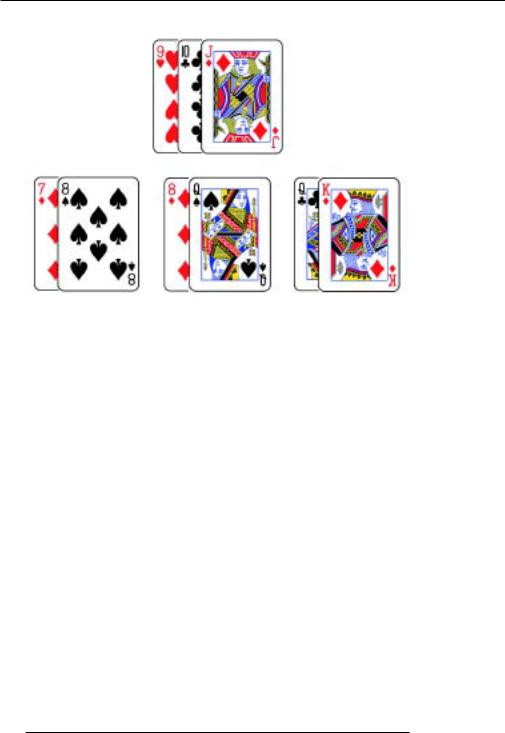
3. Odds in Texas Hold’em
For each of these 3 sets there are 4 * 4 = 16 possible combinations. Therefore, there are a total of 3 * 16 = 48 2-card combinations that will make the Straight shown:
Total Possibilities = 1,081
– WILLs = 48
WILLNOTs = 1,033
Odds of a RR Straight WILLNOTs : WILLs
1,033 : 48 Reduce
1,033 / 48 : 48 / 48
21.52 : 1
1-Gap Backdoor 3-Straight >>> Straight
With a single-gap backdoor Straight draw above 2 and below K in rank, there are 2 sets of 2-card combinations that will make the Straight:
118
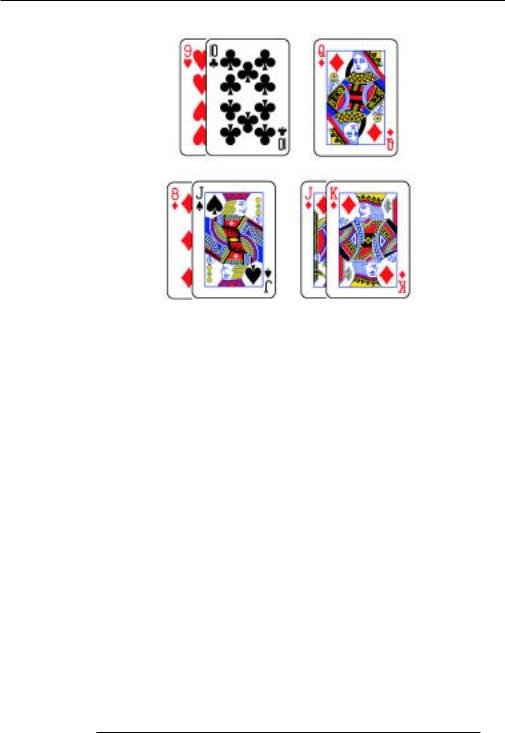
After the Flop
For each of the 2 sets there are 4 * 4 = 16 possible combinations. Thus, there are a total of 2 * 16 = 32 2-card combinations that will make the Straight shown:
Total Possibilities = 1,081
– WILLs = 32
WILLNOTs = 1,049
Odds of a RR Straight WILLNOTs : WILLs
1,049 : 32 Reduce
1,049 / 32 : 32 / 32
32.8 : 1
2-Gap Backdoor 3-Straight >>> Straight
With a 2-gap backdoor Straight draw above 2 and below K in rank, there is only 1 Set of 2-card combinations that will make the Straight:
119
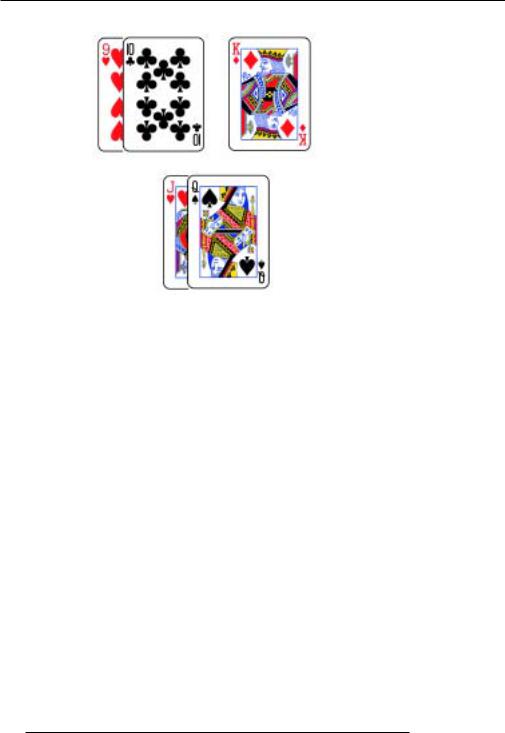
3. Odds in Texas Hold’em
With only 1 Set of 2-card combinations that will make the Straight, there are only 4 * 4 = 16 2-card combinations that will make the Straight shown:
Total Possibilities = 1,081
– WILLs = 16
WILLNOTs = 1,065
Odds of a RR Straight WILLNOTs : WILLs
1,065 : 16 Reduce
1,065 / 16 : 16 / 16
66.56 : 1
Backdoor Flush >>> Flush
With a 3-card Flush draw there are 10 cards of the right suit that remain among the 47 unseen cards. From those 10 suited cards there are Comb(10, 2):
120

After the Flop
(10 * 9) = 45 (1 * 2)
45 possible 2-card combinations that WILL make a runnerrunner Flush:
Total Possibilities = 1,081
– WILLs = 45
WILLNOTs = 1,036
Odds of a RR Flush WILLNOTs : WILLs
1,036 : 45 Reduce
1,036 / 45 : 45 / 45
23 : 1
Either Unpaired Hole Card >>> Runner-Runner Set
There are 3 2-card/pair combinations for each hole card that will make a Set. Thus there are 6 2-card combinations that will make a Set to either unpaired hole card:
Total Possibilities = 1,081
– WILLs = 6
WILLNOTs = 1,075
Odds of RR Set to Either Unpaired Hole Card WILLNOTs : WILLs
1,075 : 6 Reduce
1,075 / 6 : 6 / 6
179.2 : 1
121

3. Odds in Texas Hold’em
2 Unpaired Hole Cards >>> Runner-Runner 2 Pair
With 2 unpaired cards in the hole there are 6 cards among the remaining 47 that will pair either card.
For this calculation we will multiply the probability that the first card will pair either card by the probability that the second card will pair the remaining unpaired card.
That probability expressed as a decimal ratio to 1 is:
WILLs |
= Probability as decimal ratio to 1 |
Total Possibilities |
With 6 cards of a total of 47 that will pair either hole card, the probability that the first card will pair either hole card is:
6
47
With the first card paired there are 3 of the remaining 46 cards that will pair the remaining unpaired hole card. The probability that the second card will make the second Pair is
3
46
The probability of runner-runner pairing both unpaired hole cards is
6 |
3 |
= |
18 |
|
47 |
* |
46 |
2,162 |
|
18 = .0083
2,162
122

After the Flop
The probability of runner-runner pairing both hole cards is
.0083 or .83% — less than 1%.
To convert this decimal ratio to odds, subtract the WILLs (.0083) from the total possibility (1.0) to find the
WILLNOTs = .9917.
By approximation we know that if the probability is just under 1%, then the odds should be just over 100 to 1:
Total Possibilities = 1
– WILLs = .0083
WILLNOTs = .9917
Odds of RR to Pair Both Unpaired Hole Cards WILLNOTs : WILLs
.9917 : .0083 Reduce
.9917 / .0083 : .0083 / .0083
119.5 : 1
Open Backdoor 3-Straight Flush >>> RunnerRunner Straight Flush
With 3 suited and connected cards above 2 and below K in rank, there are 3 2-card combinations that will make a Straight Flush:
123
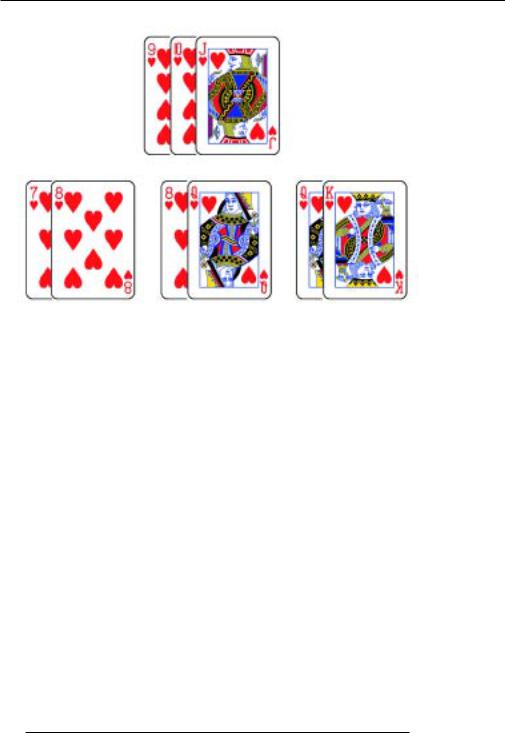
3. Odds in Texas Hold’em
Thus of a possible 1,081 2-card combinations only 3 WILL make the Straight Flush.
Knowing that with only 3 of over 1,000 possibilities you can approximate that the odds will be just over 300 to 1:
Total Possibilities = 1,081
– WILLs = 3
WILLNOTs = 1,078
Odds of a RR Straight WILLNOTs : WILLs
1,078 : 3 Reduce
1,078 / 3 : 3 / 3
359.3 : 1
124

Before the Last Card
Before the Last Card
After the Turn card has hit the board you have only 1 more card to come and only one more chance to improve your hand. But as we’ve said before: hand improvement is not the only way to win the pot.
With 1 card to come there are still 2 rounds of betting to come. In most limit games those rounds are at a higher stake than the first two.
With the higher cost to continue and the hand mostly made, players should have a precise strategy in order to remain involved.
At this juncture there are 3 ways you can win the pot:
1.Have the best hand and show it down on the River
2.Improve to the best hand on the last card and show it down on the River
3.Make a Bet, Raise or Check-Raise now and/or on the River that causes your opponent(s) to fold.
Knowing the likelihood that you can manipulate your opponent(s) into giving up the hand is a very important part of knowing your Total Odds of winning the pot. This makes knowing your opponents and their behavior an essential element to combine with the basic mathematical odds of improvement.
125

3. Odds in Texas Hold’em
Odds of Improvement
This table shows the odds of improving certain common drawing hands on the last card.
Hand - Draw |
Make on Last Card |
Odds |
|
|
|
Pair |
2 Pair |
2.8 : 1 |
|
|
|
Pair |
Set |
22 : 1 |
|
|
|
2 Pair |
Full House |
10.5 : 1 |
Set |
Quads |
45 : 1 |
|
|
|
Open Straight |
Straight |
4.75 : 1 |
Draw |
|
|
Gut-shot |
Straight |
10.75 : 1 |
St Draw |
|
|
4 Flush |
Flush |
4.11 : 1 |
4 Flush & Open |
Straight or Flush |
2.01 : 1 |
Straight Draw |
|
|
1 Pair & Open |
Set or Straight |
3.6 : 1 |
Straight Draw |
|
|
1 Pair & 4 Flush |
Set or Flush |
3.18 : 1 |
|
|
|
Open Straight |
Straight Flush |
22 : 1 |
Flush Draw |
|
|
2 Unpaired |
Pair |
6.67 : 1 |
Cards |
Either Hole Card |
|
|
|
|
The Calculations
With one card to come, the odds calculation for the various hands is straightforward. The only number that changes is the number of outs.
After the Turn card has hit the board there are 2 cards in your pocket, 4 on the board and 46 unseen cards:
126

Before the Last Card
Total Possibilities = 46
Total Possibilities – WILLs (Outs) = WILLNOTs
Odds = WILLNOTs : WILLs (Outs)
Pair >>> 2 Pair
There are 12 cards among the remaining 46 that will pair one of the 4 unpaired cards:
Total Possibilities = 46
– WILLs = 12
WILLNOTs = 34
Odds of Making 2 Pair with a Pair WILLNOTs : WILLs
34 : 12 Reduce
34 / 12 : 12 / 12
2.8 : 1
Pair >>> Set
Whether the Pair is in the pocket or the player has paired one of his hole cards, there are still only 2 cards that will make the Set among the remaining 46. The odds of making a Set from a Pair on the Turn are
Total Possibilities = 46
– WILLs = 2
WILLNOTs = 44
Odds of Making a Set with a Pair WILLNOTs : WILLs
44 : 2
127

3. Odds in Texas Hold’em
Reduce 44 / 2 : 2 / 2 22 : 1
2 Pair >>> Full House
There are 4 cards among the remaining 46 that will make the Boat:
Total Possibilities = 46
– WILLs = 4
WILLNOTs = 42
Odds of Making a Full House with 2 Pair WILLNOTs : WILLs
42 : 4 Reduce
42 / 4 : 4 / 4
10.5 : 1
Set >>> Quads
With a Set there is only 1 card among the remaining 46 that will make Quads:
Total Possibilities = 46
– WILLs = 1
WILLNOTs = 45
Odds of Making Quads with a Set WILLNOTs : WILLs
45 : 1
128

Before the Last Card
Open Ended Straight Draw >>> a Straight
There are 8 cards, 4 on each end, that will make the Straight:
Total Possibilities = 46
– WILLs = 8
WILLNOTs = 38
Odds of Making a Straight with an Open Ended Draw WILLNOTs : WILLs
38 : 8 Reduce
38 / 8 : 8 / 8
4.75 : 1
Gut-shot Straight Draw >>> Straight
With a gut-shot Straight draw there are 4 cards among the remaining 46 that will complete the draw:
Total Possibilities = 46
– WILLs = 4
WILLNOTs = 42
Odds of Making a Straight with a Gut-shot Draw WILLNOTs : WILLs
43 : 4 Reduce
43 / 4 : 4 / 4
10.75 : 1
4 Flush >>> Flush
Again, whether there are 2 suited cards in the pocket or 1 suited card in the hole and 3 suited on the board, there are
129

3. Odds in Texas Hold’em
still 9 cards among the unseen 46 that will complete the Flush:
Total Possibilities = 46
– WILLs = 9
WILLNOTs = 37
Odds of Making a Flush with a 4-Flush WILLNOTs : WILLs
37 : 9 Reduce
37 / 9 : 9 / 9
4.11 : 1
Open Straight Draw & 4 Flush >>> Straight or Flush
With an open ended Straight draw there are 8 outs to the Straight. With a 4 Flush there are 9 cards that will make the Flush. Because 2 of these cards will make both the Straight and the Flush there are 9 + 8 – 2 = 15 outs to either the Straight or the Flush:
Total Possibilities = 46
– WILLs = 15
WILLNOTs = 31
Odds of Making a Straight or a Flush WILLNOTs : WILLs
31 : 15 Reduce
31 / 15 : 15 / 15
2.06 : 1
130

Before the Last Card
Pair & Open Straight Draw >>> Straight or Set
With a Pair and an open Straight draw there are 10 cards that will make either a Straight or a Set:
Total Possibilities = 46
– WILLs = 10
WILLNOTs = 36
Odds of Making a Set or Straight with a Pair & Open Straight Draw
WILLNOTs : WILLs 36 : 10 Reduce
36 / 10 : 10 / 10
3.6 : 1
Pair & 4 Flush >>> Flush or Set
With a Pair and a Flush draw there are 11 cards that will make either a Flush or a Set:
Total Possibilities = 46
– WILLs = 11
WILLNOTs = 35
Odds of Making a Flush or Set WILLNOTs : WILLs
35 : 11 Reduce
35 / 11 : 11 / 11
3.18 : 1
131

3. Odds in Texas Hold’em
Open Ended Straight Flush Draw >>> Straight Flush
There are only 2 cards, either one of which will complete the Straight Flush draw:
Total Possibilities = 46
– WILLs = 2
WILLNOTs = 44
Odds of Making a Straight Flush WILLNOTs : WILLs
44 : 2 Reduce
44 / 2 : 2 / 2
22 : 1
2 Unpaired Hole Cards >>> a Pair
With 2 unpaired hole cards there are 6 cards among the remaining unseen 46 cards that will make a Pair:
Total Possibilities = 46
– WILLs = 6
WILLNOTs = 40
Odds of Making a Pair w/2 Unpaired Hole Cards WILLNOTs : WILLs
40 : 6 Reduce
40 / 6 : 6 / 6
6.67 : 1
132

The River Bet — Last Chance to Earn
The River Bet — Last Chance
to Earn
All the cards are out — there is no chance of improving your hand. You can win now in one of two ways:
1.By having the best hand in a showdown
2.By using strategy to cause your opponent(s) to fold their cards.
Remember — your Total Odds of winning the pot are the odds that your hand will win in a showdown combined with the odds that you can manipulate your opponent(s) into giving up their stake in the pot.
It is at this point in the hand where the concepts of ValueBet and Value-Call are most plainly demonstrated.
By this stage, three of the four rounds of betting have been completed. Pots are often large enough to offer positive money odds to a variety of seemingly risky propositions.
In a heads-up situation, if your best assessment is that you are a 3 to 1 dog to win the pot, but there are 10 bets in the pot, then there is an overlay to a call or a bet even without giving any consideration to whether or not your opponent(s) will call or fold.
There are 2 important points to remember on the River:
1.The greater your understanding of your opponents’ likely reactions, the less you have to depend of the strength of your hand
133

3. Odds in Texas Hold’em
2.The greater the strength of your hand, the less you have to worry about your opponents’ reactions and the more you want them to call or raise.
The last round of betting can offer a great reward to a bold strategy.
With many bets in the pot and good knowledge of your opponent(s), a bet, a raise or even a check-raise with a busted draw can often pay as well as a completed draw.
The most valuable ability in all of Poker is the ability to win without having the best hand!
All players get the same number of good hands. It is the rare and often extremely successful player who can win pots with very strong hands and very weak hands alike.
134
